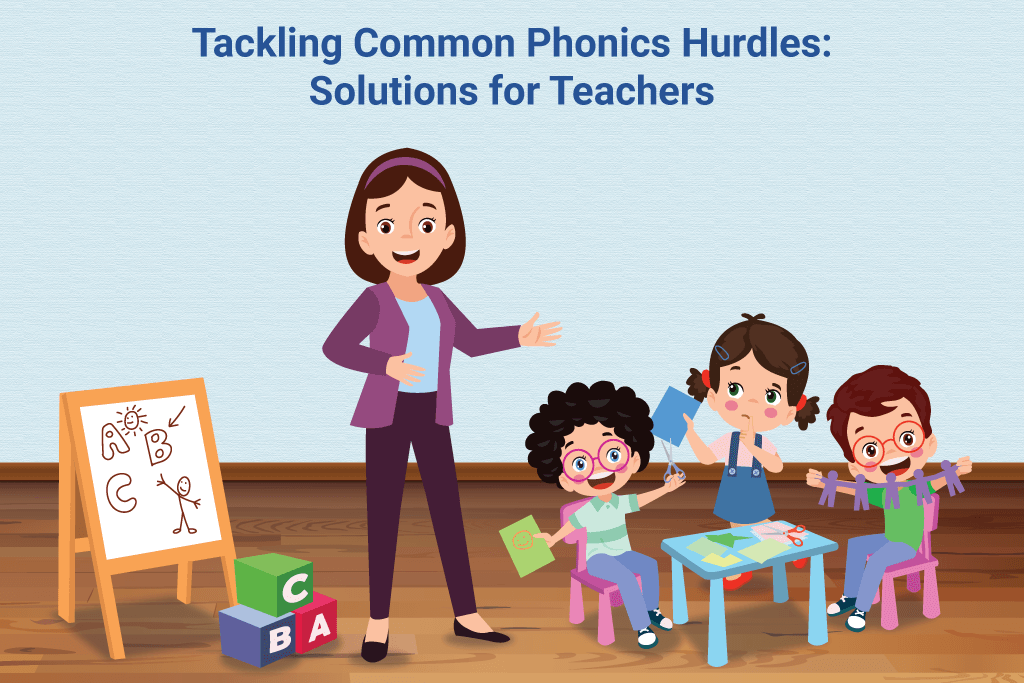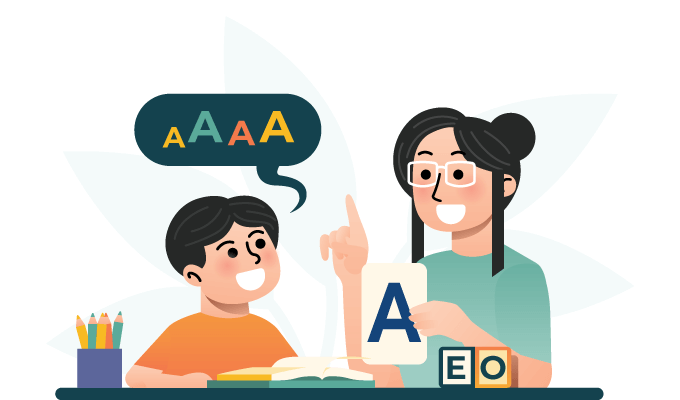Tackling Common Phonics Hurdles: Solutions for Teachers

Phonics is an essential method of teaching students phonemic awareness. It helps students develop language and grammar skills that bring confidence in conversation. However, teaching phonics does not come without challenges. Phonics tutors face several hurdles that can impact the quality of education a student receives.
Mostly, the common phonics challenges arise because teachers don’t have access to quality resources. In some cases, they do not receive adequate training to deliver the best phonemic awareness to children.
In this blog, we will address some of the most basic problems that teachers encounter while teaching phonics. We will also look at some solutions that can be implemented to improve the quality of phonics education.
Explore effective solutions for phonics hurdles – take action today!
A] What Is Phonics?
Phonics focuses on teaching students the relationship between letters and sounds. It helps students understand the relationship between individual letters and how they have a specific sound in a word.
Developing phonemic awareness lets children blend words easily. With this awareness, they can easily read or spell words. Phonics also aims at teaching students how to decode and sound unfamiliar words.
Phonics develops language and grammar skills in students that improve their literacy. However, while providing students with phonics education, a lot of challenges surround teachers. Let us look at those challenges and see how it is possible to overcome them.
B] Common Phonics Problems For Teachers
The below-mentioned are some challenges of teaching phonics.
1. Lack Of Resources To Teach Phonics
The most common problem that almost all phonics teachers complain about is the lack of resources to teach phonics. There is a lack of research on this area of study. Phonics tutors have difficulty accessing resources that provide them with in-depth tutoring instruction. Some tutors are not able to conduct proper research due to lack of time.
2. Non-Availability Of Training
The availability of training for phonics instruction is very scarce. Finding a proper phonics course and enrolling in it can be a little difficult for teachers. In most organisations, tutors do not receive in-service training from the start. So, they do not have the right knowledge of phonological awareness which affects their quality of teaching.
3. Inadequate Practice Of Phonological Awareness
To impart the best phonological awareness among children, practice is essential. When teachers are not provided with on-the-job training, it can be challenging for them to understand how to teach children effectively.
Tutors do not get sufficient materials to understand the systematic approach to practising phonological awareness and teach the same to students. However, enrolling in a jolly phonics online course for teachers can provide relief to phonics teachers.
4. Difficulty In Helping Students Differentiate Between Similar-Looking Letters
Once students start recognising letters, it can be confusing for teachers to understand what the student is trying to convey. For example, b, d, g, p, and q look almost similar as they all have circles.
Sometimes, teachers might struggle to help them differentiate how the sticks of all these letters go in different directions. This problem arises only due to a lack of phonics training.
5. Confusing Blends And Tricky Blends
In a phonics class, a student learns different blends that look similar. Teachers face the problem of helping students differentiate between how these blends sound. Also, there are many tricky words that students might find hard to decode. In such a case, some phonics tutors might not be able to find a way out to help students.
C] Solutions For Phonics Teachers
As a phonics teacher, if you face the above-mentioned problems, here are a few solutions you can implement.
1. Seek Online Platforms For More Resources
The availability of offline materials that guide you on how to teach phonics is not much. However, the internet is a sea of knowledge and you can explore numerous resources that guide you about teaching phonics. These resources can be very insightful and help you enhance your phonics knowledge.
2. Conduct And Attend Conferences And Workshops For Training
Phonics teaching organisations can conduct workshops to help teachers understand the basics of phonemics. Teachers must attend these workshops or conferences to strengthen their grip on phonemic awareness.
Additionally, phonics instructors can explore any phonics course for teachers that will help in improving their knowledge.
3. Incorporate Phonological Awareness Activities Into Daily Routines
Incorporating phonological awareness activities into daily routines is another way teachers can overcome the hurdles of teaching phonics. Teachers can take the help of songs, rhymes, etc., to point out unfamiliar words and sounds.
Phonics tutors can also help students learn new sounds and words by breaking them while talking to them. Apart from this, many play activities help in bringing phonological awareness to children.
4. Employ Visual Aids And Mnemonics To Teach Students
Phonics instructors can also use visual aids and mnemonics in teaching phonics. Mnemonics can help students create imagery and patterns to retain the information. Children are more perceptible to retain what they see. Visual aids and mnemonics will help in developing phonological awareness in students more effectively.
5. Break Down Blends Into Smaller Parts
Finally, breaking down blends into smaller parts is one of the best ways to overcome the challenges of teaching phonics. For example, if you are teaching students how to pronounce and spell ‘because,’ you can break down the word into two sections – ‘be’ and ‘cause.’
Students often find it easy to remember smaller words. So, when they see this word in a complex sentence, they can easily decode it.
Explore effective solutions for phonics hurdles – take action today!
Conclusion
Phonics is a quick and the best method to help students understand the letter-sound relationship. A student who has a good grasp of phonics can develop the best reading and writing skills. However, the problem arises when the student cannot get the right phonics knowledge. This problem occurs because teachers encounter several problems while teaching phonics to students.
The challenges discussed above are the most common phonics challenges for teachers. But these challenges are surmountable. Teachers only need to focus on accessing the right resources and getting proper training.
The solutions mentioned above will help teachers develop phonological awareness to teach students in the best way possible. If you are struggling to find the best phonics training for teachers, you can contact Phonic Smart.

Hema Dave
Stemming from the aspiration to nurture and inspire young minds, Hema started her professional journey into education 20+ years ago. She founded 'Phonic Smart' as a trained educationist, an institute committed to equipping children with phonics skills and helping parents and teachers implement them effectively. Her diverse skill sets, encompassing teaching, teacher training, and coaching allow her to contribute valuable insights to the education industry.

